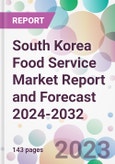According to the report, the South Korea food service market is projected to grow at a CAGR of 4.4% between 2024 and 2032 reaching a value of approximate USD 196.08 billion by 2032. Aided by the nation's modern urban landscape, burgeoning middle class, and the dynamic cultural phenomenon, the Korean Wave, the market is expected to grow significantly by 2032.
South Korea's food service landscape is an eclectic mix of traditional eateries, contemporary cafes, and cutting-edge fine dining establishments. The country, known for its rich culinary traditions, also celebrates an ever-evolving food culture, seamlessly amalgamating age-old traditions with contemporary tastes and international cuisines.
One pivotal driver steering the South Korea food service market growth is the increasing urban population coupled with soaring disposable incomes. As urban centres flourish and expendable incomes rise, the allure of dining out, experimenting with global cuisines, and the overall experience-centric nature of urbanites significantly bolster this market.
Simultaneously, the global fascination with Korean culture, predominantly driven by K-pop, dramas, and films, known collectively as the Korean Wave or"Hallyu", has inadvertently accentuated the global appetite for Korean food. As per the South Korea food service market analysis, this phenomenon, in turn, catalyses the domestic food service sector, with restaurateurs and chefs keen to innovate and redefine traditional recipes to cater to both domestic and international palates.
Additionally, the modern South Korean consumer's discerning taste plays a pivotal role. With an accentuated focus on health, wellness, and dietary preferences, there's a growing demand for diverse, high-quality, and health-conscious menus, which propels the South Korea food service market demand. This trend, in particular, has seen a surge in demand for organic, vegan, and vegetarian food options.
The country has also seen a proliferation of theme-based cafes, pop-up eateries, and experiential dining spaces, where food service is married with art, culture, or entertainment. This shift towards experience-driven dining further amplifies the sector's potential.
Advancements in technology, especially in the realm of digital payments and online delivery platforms, is one of the crucial South Korea food service market trends. As the nation rapidly digitizes, food delivery apps and online reservation systems have become the norm rather than the exception. The convenience of ordering a meal or reserving a table with just a few taps has significantly streamlined the dining experience.
South Korea's food service landscape is an eclectic mix of traditional eateries, contemporary cafes, and cutting-edge fine dining establishments. The country, known for its rich culinary traditions, also celebrates an ever-evolving food culture, seamlessly amalgamating age-old traditions with contemporary tastes and international cuisines.
One pivotal driver steering the South Korea food service market growth is the increasing urban population coupled with soaring disposable incomes. As urban centres flourish and expendable incomes rise, the allure of dining out, experimenting with global cuisines, and the overall experience-centric nature of urbanites significantly bolster this market.
Simultaneously, the global fascination with Korean culture, predominantly driven by K-pop, dramas, and films, known collectively as the Korean Wave or"Hallyu", has inadvertently accentuated the global appetite for Korean food. As per the South Korea food service market analysis, this phenomenon, in turn, catalyses the domestic food service sector, with restaurateurs and chefs keen to innovate and redefine traditional recipes to cater to both domestic and international palates.
Additionally, the modern South Korean consumer's discerning taste plays a pivotal role. With an accentuated focus on health, wellness, and dietary preferences, there's a growing demand for diverse, high-quality, and health-conscious menus, which propels the South Korea food service market demand. This trend, in particular, has seen a surge in demand for organic, vegan, and vegetarian food options.
The country has also seen a proliferation of theme-based cafes, pop-up eateries, and experiential dining spaces, where food service is married with art, culture, or entertainment. This shift towards experience-driven dining further amplifies the sector's potential.
Advancements in technology, especially in the realm of digital payments and online delivery platforms, is one of the crucial South Korea food service market trends. As the nation rapidly digitizes, food delivery apps and online reservation systems have become the norm rather than the exception. The convenience of ordering a meal or reserving a table with just a few taps has significantly streamlined the dining experience.
Market Segmentation
The market can be divided based on type, structure, and sector.
Market Breakup by Type
- Full-service Restaurants
- Quick-service Restaurants
- Street Stalls and Kiosks
- Cafes and Bars
- Others
Market Breakup by Structure
- Independent Consumer Foodservice
- Chained Consumer Foodservice
Market Breakup by Sector
- Commercial
- Non-Commercial
Competitive Landscape
The report looks into the market shares, plant turnarounds, capacities, investments, and mergers and acquisitions, among other major developments, of the leading companies operating in the South Korea food service market. Some of the major players explored in the report are as follows:- Starbucks Corporation
- Yum! Brands, Inc.,
- McDonald's Corporation
- Balwoo Gongyang
- Yongsusan
- Burger King Corporation
- Others
Table of Contents
1 Preface2 Report Coverage - Key Segmentation and Scope4 Key Assumptions6 Market Snapshot7 Industry Opportunities and Challenges11 Key Trends and Developments in the Market
3 Report Description
5 Executive Summary
8 South Korea Food Service Market Analysis
9 Market Dynamics
10 Competitive Landscape
List of Figures and Tables
Companies Mentioned
- Starbucks Corporation
- Yum! Brands Inc.
- McDonald's Corporation
- Balwoo Gongyang
- Yongsusan
- Burger King Corporation
Methodology

LOADING...








